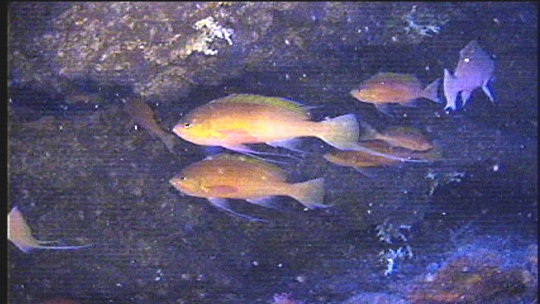
It was my colleague, Richard White, who suggested the idea. Richard is one of the best observers I have ever known, particularly when it comes to seabirds, whales and other wildlife at sea. Whenever we are cruising from one destination to another, he spends the majority of his time on the bridge, maintaining a keen lookout.
On this occasion, on the National Geographic Explorer, we were making our way north through the tropical Atlantic, following the Mid-Atlantic Ridge between the remote islands of St. Helena and Ascension. Richard had been studying the nautical charts of the area and noticed that our course would take us near the summit of Grattan Seamount, an underwater mountain that rises to less than 300 feet below the surface. He suggested to me that we might be able to make a mid-ocean stop and use our Remote Operated Vehicle (ROV) to have a look at this unexplored submarine mountaintop.

Launching the ROV in Anvord Bay in Antarctica. All rights reserved.
The ROV is a small, unmanned submarine about three feet long. Powered by electric thrusters, it descends at the end of a thick cable that carries the operator's commands down and the video signal back up to the surface. As the operator, I sit in a control station in a Zodiac, looking into a monitor that shows the images from the ROV's camera, and "flying" it with a set of joysticks and toggle switches.
It's not easy to drop the ROV onto a small mountaintop, far below the surface, in the middle of an ocean, but I was determined to give it our best shot. We sent it down through the clear blue water with our fingers crossed. On the surface the Zodiac was pitching and rolling on the mid-Atlantic swells, which made staring into the monitor rather uncomfortable, but before long I could see the summit of the seamount coming into view. We had found it! Sea conditions completely forgotten, I gently touched the ROV down on the sand and began to explore.
The first thing I noticed was the geology: Grattan Seamount is a guyot, an ancient volcano that has had it's top eroded into a flat plateau by waves. As I carefully flew the ROV toward the edge of the summit platform, formations of more recent, jagged volcanic rocks came into view, a better habitat for small fish. Though I had seen an unusual crab on the flat part of the summit, the number and diversity of fish increased dramatically in the area of the rocks. There were butterflyfish and damselfish, bigeyes and jacks, and best of all, sheltering in a small cave, a beautiful fairy basslet.

St. Helena Basslets, Holanthias fronticinctus, at 380 feet depth on Grattan Seamount. Photo by David Cothran. All rights reserved.
Back on board, I worked to research what I had seen. It soon became apparent that the images I had just shot were the first ever taken of Grattan Seamount. And the beautiful basslet turned out to be a very rare fish indeed; after a lot of searching I was finally able to confirm that it was Holanthias fronticinctus, the St. Helena basslet, previously known only from St. Helena island, 640 miles to the southeast! Not only that, but to the best of my knowledge the only time the species has ever been photographed in the wild.
I was elated! Our ROV is a very powerful tool; using it had allowed all of us traveling on the National Geographic Explorer to participate in an exciting discovery that we are now sharing with the scientific community. And the potential for further exploration is enormous; every time we put it into the water, the ROV allows us look into another small part of our planet that humans have never seen before.